Automatic Capping Machines for All Your Product Capping Needs
Our capping machines are designed to fast-track the packaging of products, providing unrivalled speed, precision and consistency. By automating cap feeding, ensuring accurate torque control and blending with other production lines, these machines will greatly improve operational efficiency and throughputs.
Showing all 8 results
-

Auto Liquid Paste Filling Sealing Cap...
View Machines -
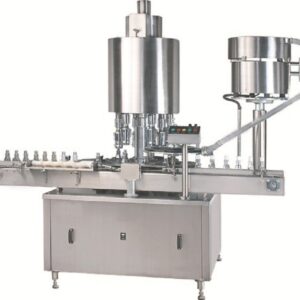
Automatic Capping Machine
View Machines -
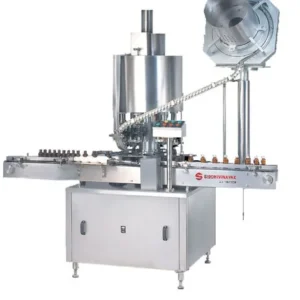
Bottle Capping Machine
View Machines -

Capping Machine
View Machines -
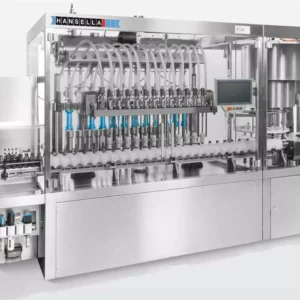
Filling and Capping Machine
View Machines -
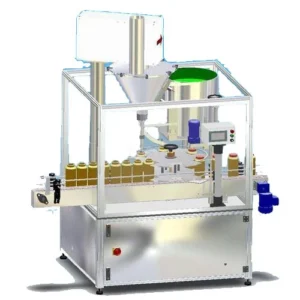
Liquid Bottle Capping Machine
View Machines -
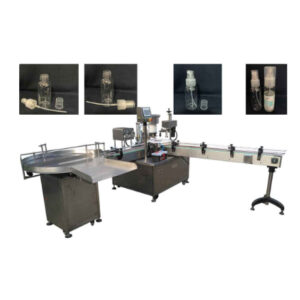
Liquid Nasal Spray Bottle Filling Cap...
View Machines -

Oral Liquid Syrup Glass Roll Bottle F...
View Machines
What is Capping Machine
The Capping Machine is very important in the packaging industry as it makes sure the containers are properly sealed with caps or covers. Various types and setups of capping machines are there for different packaging requirements, ranging from bottles to jars. In this survey, we will comprehensively look at capping machines discussing their types, functions, uses and how industries globally benefit from them.
Types of Capping Machines
Capping machines come in different configurations, all tailored for specific sealing needs and production capacities:
Screw Capping Machines:
They can effectively fix screw caps on bottlenecks using rotary motion with accuracy and speed.
Some variants include inline screw cappers, rotary chuck cappers, and spindle cappers, which have capabilities that are necessary for varied bottle and cap types.
ROPP (Roll-On Pilfer Proof) Capping Machines:
These cappers roll the caps onto the bottles which makes them secure, and safe from tampering or any other kind of damage thus preserving their product integrity especially when it comes to aluminium caps ROPP type.
The advanced versions even have servo-driven systems that allow better control of torque application hence ensuring uniform sealing quality.
Snap Capping Machines:
Snap cappers in the beverage industry snap-on caps on water bottles as well as juices and carbonated drinks for easy covering.
Press-on Capping Machines:
This approach involves either mechanical/pneumatic pressure where the press-on capper squeezes the cap tightly against the bottleneck without any threads. Hence ensuring air tightness.
Corking Machines:
In winemaking corking machines gently put plugs into bottles so they keep the wine’s taste therefore adding a touch of elegance to it at the same time.
Chuck Capping Machines:
Chuck cappers with adjustable chuck heads screw down various-sized bottles securely preventing leaks while maintaining freshness.
Operational Dynamics of Capping Machines
The operational dynamics of capping machines encompass a series of synchronized steps, orchestrated to seamlessly seal bottles with precision and efficiency:
Cap Feeding and Orientation:
Caps are fed into the capping machine either manually or via automated feeders, ensuring a steady supply for uninterrupted production.
Sophisticated systems employ sensors and vision inspection technology to orient caps correctly, aligning them for precise placement onto bottle openings.
Bottle Handling and Positioning:
Bottles are conveyed into position, guided by conveyor systems or robotic arms, ready to receive caps with optimal alignment and stability.
Capping Mechanism Engagement:
Depending on the machine type, the capping mechanism is activated, applying the necessary force, torque, or pressure to affix caps securely onto bottle necks.
Torque adjustment features allow operators to fine-tune sealing parameters, ensuring consistency and preventing over-tightening or under-tightening of caps.
Tamper-Evident Features and Secondary Sealing:
In industries where product integrity is paramount, capping machines may incorporate additional features such as induction sealing for foil liners or shrink wrapping for plastic caps, providing tamper-evident seals and enhanced protection against contamination.
Applications Across Industries
The versatility of capping machines finds expression across a diverse spectrum of industries, where they serve as indispensable assets in packaging operations:
-
Beverage Industry:
- Capping machines play a pivotal role in sealing bottles containing water, soft drinks, juices, energy drinks, and alcoholic beverages, ensuring product freshness and preventing leakage during storage and transportation.
-
Pharmaceutical Sector:
- In pharmaceutical manufacturing facilities, capping machines safeguard the integrity and safety of medications, vitamins, and healthcare products, adhering to stringent regulatory standards for tamper resistance and contamination control.
-
Food and Condiments Production:
- Capping machines seal bottles containing sauces, condiments, oils, dressings, marinades, and other food products, extending shelf life and preserving flavor profiles while minimizing the risk of spillage or spoilage.
-
Cosmetics and Personal Care Industry:
- From shampoos and lotions to perfumes and skincare products, capping machines ensure hermetic seals for cosmetic and personal care items, maintaining product freshness and enhancing brand appeal through sleek and secure packaging.
-
Chemical and Industrial Applications:
- In the chemical and industrial sectors, capping machines seal bottles containing cleaning agents, lubricants, solvents, adhesives, and specialty chemicals, safeguarding product integrity and facilitating safe handling and storage.
Functionalities of Capping Machine
Cap Feeding
The supply of caps or lids to be applied to containers by a particular equipment is referred to as cap feeding. Given the different types of caps that are available and the speed at which a packaging line runs, there are many methods for cap feeding. Vibratory bowl feeders, rotary feeders and conveyor belt systems form some of the usual cap feeding mechanisms.
Cap Sorting and Orientation
Following cap feeding into capping machinery, the next step is cap sorting and orientation. It entails proper positioning and orientation of caps in readiness for installation on containers. Sophisticated capping machines apply sensors, vision systems or mechanical devices to identify and orientate these before they can be sealed.
Container Handling
Containers during the sealing process are dealt with through special features embedded in capper machines. Containers are held in position by conveyors, grippers or clamps while lids are being fixed. These systems ensure that all containers are accurately aligned concerning their position.
Cap Placement
The most important purpose of capping machines is placing caps on containers. Depending on whether screwing, snapping, pressing or induction sealing will be done on the caps; different techniques will be used when capping machines place them on top of bottles. The use of precision engineering and control systems ensures that cap placement always takes place correctly enough times to give an air-tight seal every time it is required.
Torque Adjustment
Another important feature used in operating capping machines is torque adjustment which refers to rotational force applied when securing a container’s cap. Depending on the type of lids involved, their diverse containment units as well and what seals need tightening then workers can adjust torque settings accordingly via such devices as these here below CAPPING MACHINES – Torque Adjustment: Tamp-down Chuck Force Adjustments Displays Adjustable Spindle Height Cap Handling Operations Control Panel Manual Clutch Adjustment Rotary Indexer Controls Precise torque adjustment without damaging either container or cap is necessary for sealing.
Tightening Mechanism
The process of fitting a cap onto a container requires some form of tightening mechanism in capping machines. These include such things as grippers, chuck assemblies and pneumatic actuators depending on the method of capping. By doing so, these machines ensure that the seals are uniform across all containers being passed along the production line.
Quality Control Systems
Current capping equipment has features that check and keep the seal intact. The quality control systems here can be those using sensors, vision or even pressure equipment to notice any defects or differences in sealing. This prevents wastage and ensures product quality by quickly identifying problems early on.
Speed and efficiency
Capping machines play an important role in high-speed packaging lines because they offer great efficiency. They run at top speed but still maintain precision and dependability. Advanced automation features like servo-driven mechanisms and programmable logic controllers (PLCs) enable maximum throughput while minimizing downtime.
Versatility and Flexibility
For this reason, these machines are capable of handling different types of containers with varying shapes, sizes and caps. To adapt to new manufacturing requirements as well as fluctuating packing patterns, these devices allow substantial adjustability in terms of their settings regarding quick changeover capability among others CAPPING MACHINES – Versatility & Flexibility: Stainless Steel Construction Tool-less Changeover Height Adjustments Cap Tightening Control System Powers the Sales Team Quick-Change Spindle Assemblies Bottle Clamping Stability Multiple Options for Automated Induction Sealing Safety Features Safety design is one of the considerations made when making up a capper machine because people working around it need to be protected throughout its operation time.
Advantages and Technological Advancements
The adoption of capping machines confers numerous advantages to manufacturers, bolstered by ongoing technological innovations:
Enhanced Efficiency and Productivity:
Capping machines streamline the packaging process, accelerating production rates and reducing cycle times, thereby enhancing overall efficiency and throughput.
Consistency and Quality Assurance:
Through precise torque control and sealing parameters, capping machines ensure uniformity in cap application, minimizing defects and ensuring consistently high-quality seals across production batches.
Cost Optimization and Resource Utilization:
By automating repetitive tasks and minimizing reliance on manual labor, capping machines yields cost savings for manufacturers, optimizing resource utilization and maximizing operational profitability.
Flexibility and Adaptability:
Modern capping machines are engineered for versatility, capable of accommodating a wide range of bottle sizes, shapes, and cap types, thereby offering flexibility to manufacturers in adapting to changing market demands and product specifications.
Integration with Smart Manufacturing Systems:
With the advent of Industry 4.0 technologies, capping machines are increasingly integrated with smart manufacturing systems, enabling real-time monitoring, predictive maintenance, and data-driven optimization of production processes for enhanced operational efficiency and performance.
Key Points to Consider While Choosing Capping Machines
Speed and Throughput
One of the critical factors to consider is the machine’s speed and throughput capacity. Manufacturers should assess their production requirements and choose a capping machine that aligns with the desired packaging speed to meet market demands.
Cap Compatibility
Different packaging lines may require varying cap types and sizes. It is essential to select an automatic capping machine that can accommodate the specific caps needed for the intended products. This ensures compatibility and avoids the need for frequent adjustments or changeovers.
Torque Control
Accurate torque control is crucial in maintaining the quality and integrity of the packaged product. Automatic capping machines with adjustable torque settings allow manufacturers to customize the tightness of caps based on product requirements, preventing issues such as leaks or damaged packaging.
Ease of Maintenance
Selecting a capping machine with user-friendly maintenance features is essential for minimizing downtime and ensuring continuous production. Look for machines with easily accessible components, straightforward cleaning procedures, and comprehensive documentation for routine maintenance tasks.
Integration with Packaging Line
An automatic capping machine should seamlessly integrate into the existing packaging line. Compatibility with other machinery, such as fillers and labelers, is essential for creating a cohesive and efficient production process.
FAQ
1. What is an Automatic Capping Machine, and how does it work?
An Automatic Capping Machine is a packaging equipment designed to securely seal containers with caps or lids. It operates through a series of automated steps, including cap sorting, placement, and precise torque control to ensure a consistent and secure seal.
2. What types of caps can an Automatic Capping Machine handle?
Automatic Capping Machines are versatile and can handle various cap types, including screw caps, snap caps, and press-on caps. The machines are adaptable to different packaging needs and cap specifications.
3. How does torque control contribute to the quality of capping?
Torque control is crucial in preventing under-tightening or over-tightening of caps. Automatic Capping Machines with adjustable torque settings ensure that caps are tightened to the desired specifications, maintaining product quality and integrity.
4. What are the advantages of using Automatic Capping Machines in production?
Automatic Capping Machines offer increased efficiency, consistency, and accuracy in the capping process. They contribute to higher production speeds, reduced labour costs, and versatile applications across various packaging lines.
5. Can Automatic Capping Machines be integrated with other packaging machinery?
Yes, Automatic Capping Machines can be seamlessly integrated into existing packaging lines. Compatibility with other machinery, such as fillers and labour labourers, ensures a cohesive and efficient production process.
6. What factors should be considered when selecting an Automatic Capping Machine?
Key considerations include speed and throughput, cap compatibility, torque control, ease of maintenance, and integration with the packaging line. Assessing these factors helps in choosing the right machine for specific production requirements.
7. How does an Automatic Capping Machine contribute to cost savings?
By automating the capping process, companies can reduce reliance on manual labor, leading to significant cost savings over time. The efficiency and speed of Automatic Capping Machines also contribute to increased overall production.
8. Can Automatic Capping Machines handle different sizes of containers?
Yes, Automatic Capping Machines are designed to accommodate a range of container sizes. They offer flexibility in handling containers of various shapes and volumes, making them suitable for diverse packaging needs.
9. What maintenance is required for Automatic Capping Machines?
Automatic mapping machines typically require routine maintenance, including cleaning and inspection of components. Choosing machines with user-friendly maintenance features ensures minimal downtime and prolonged machine life.
10. Are Automatic Capping Machines suitable for specific industries?
Yes, Automatic Capping Machines find applications across various industries, including food and beverage, pharmaceuticals, cosmetics, and more. Their adaptability and versatility make them ideal for sealing products in different sectors.
